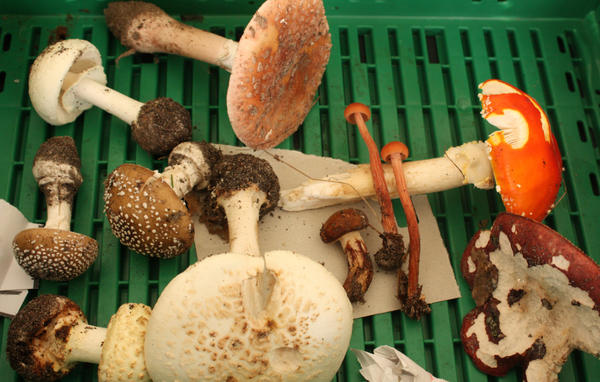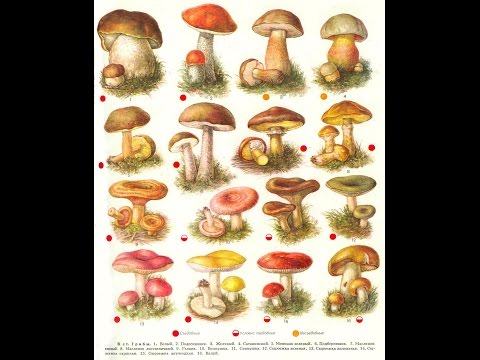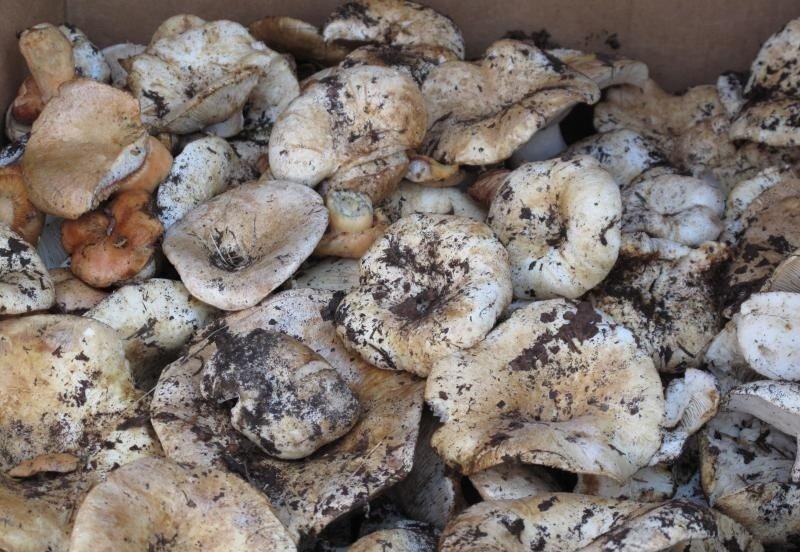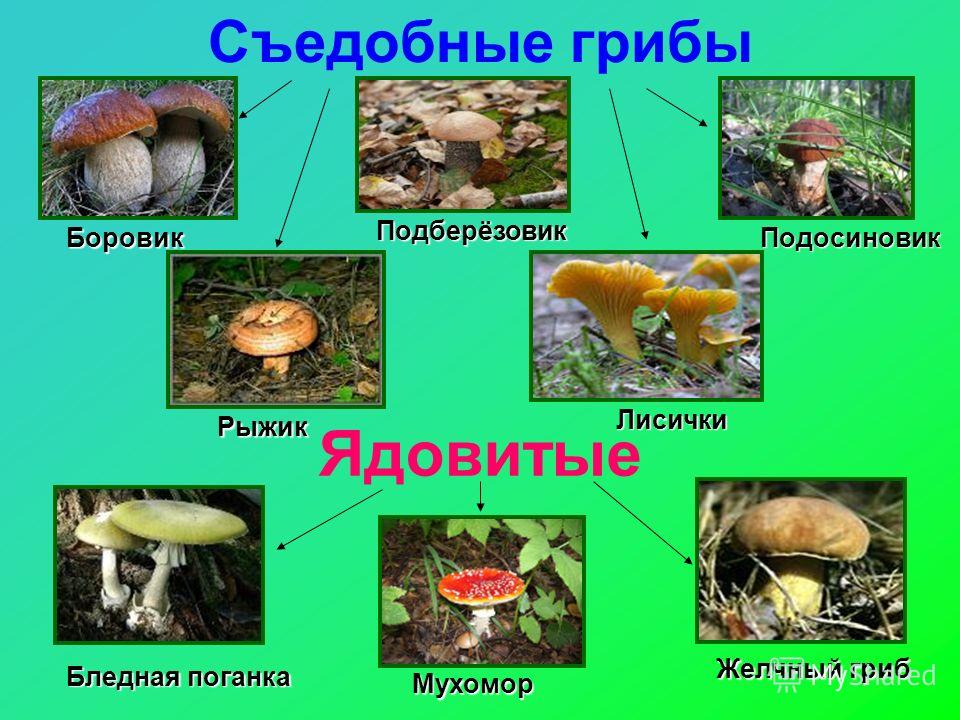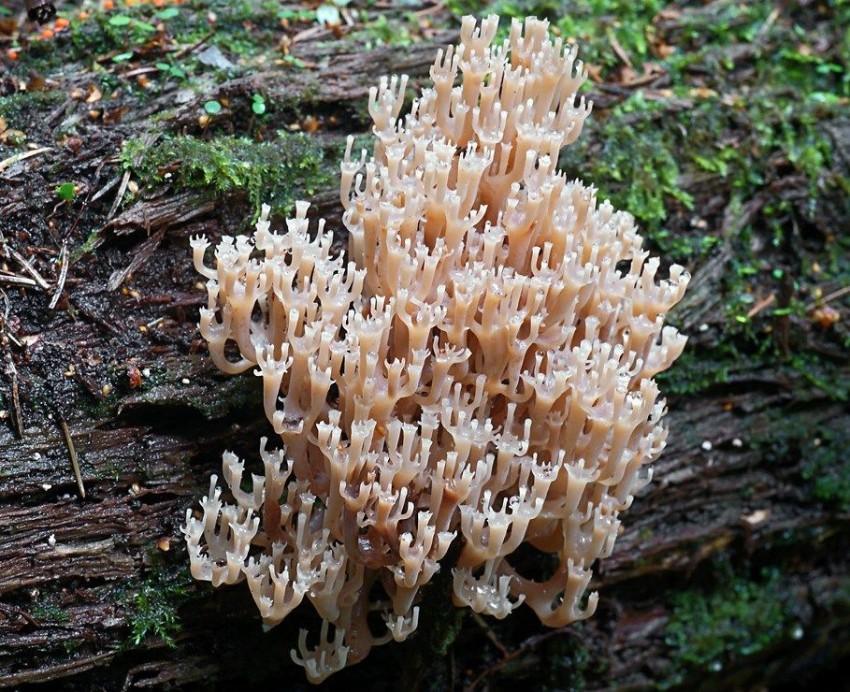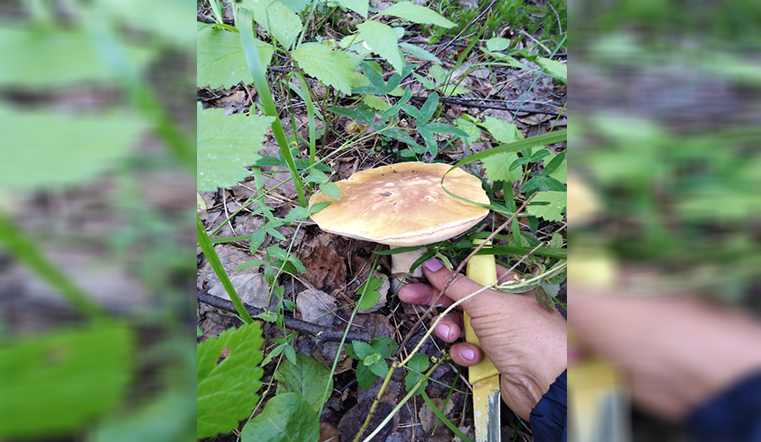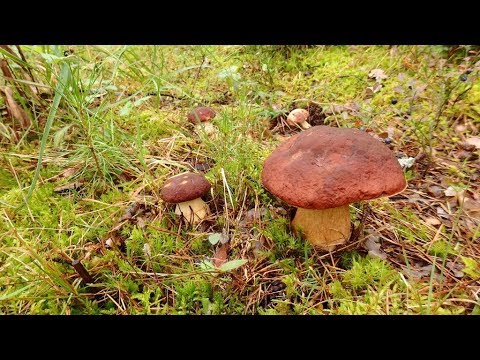Poisonous mushrooms
Interesting Facts:
- most of the listed representatives are used as raw materials for the manufacture of medicines;
- Amanita muscaria was used by the ancient Vikings before going into battle to reduce sensitivity to pain;
- inedibles are eaten after prolonged special processing;
- it is impossible to destroy the poisonous representatives of the mushroom kingdom, because they are part of the ecosystem and play an important role in cleaning the environment;
- the most poisonous mushroom in the world - pale toadstool;
- spring representatives are less toxic than those growing in the summer season (information concerns conditionally poisonous specimens);
- the benefit of poisonous basiomycetes is the ability to use an extract from them in agriculture, to create fungicides that prevent the spread of pests and fungal diseases.
Each mushroom picker should have a reminder: "do not take mushrooms that you do not know"
The collection site should be chosen carefully: Basidiomycetes collected near the highway are especially toxic. The mushroom picking season begins in May-June and lasts until the first frost (it depends on the region of residence of the mushroom picker)
Many poisonous varieties are easily recognized by cutting the fruit body.
Deadly types of mushrooms are very common disguised as edible (mushrooms are twins), so you need to be able to distinguish them.
Village Kashino

The leading place in my (personal) list is occupied by the village of Kashino, near the town of Sysert. The area was described as a “mushroom picker paradise” in a 1960 guidebook. There you can get butter. These mushrooms are great for those who love fried potatoes. Choose locations with low grass and mixed forest. You can get from Yekaterinburg by bus from the Southern Bus Station. The journey will take less than an hour.
Mount Wolf
The next item on my list is for those who love pickled and pickled mushrooms. In the area of the Volchikha Mountain, you can collect waves and saffron milk caps. These mushrooms often coexist in meadows. They do not like to hide in the shade, so they meet in open places where the sun falls during the day. You can get there by train from Yekaterinburg, in the direction of Revda. We leave at the Sportivnaya station. Drive for about an hour.
The third place of the mushroom rating is occupied by forests near the city of Nevyansk. What can a mushroom picker pick up here? Here is the "abode" of porcini mushrooms! They are attracted by coniferous forests, so they are even affectionately called "pine trees". This area can be reached by any bus from the Northern Bus Station or by train. Get off at the station Nevyansk. Next, you need to go to the opposite side from the reservoir.
Lake Tavatui
The fourth point of the rating is for those who prefer to walk less and collect in “handfuls”. It will be about mushrooms. They love boggy, dampness and hemp. Such places in the Sverdlovsk region can be found in the area of Lake Tavatui. I recommend taking any bus towards Nevyansk. Further, after passing the sign "Tavatui" you should get off and go to the side of the lake. For such a route, be sure to provide waterproof shoes!
 Village Kosulino
Village Kosulino
The sixth point will be useful for those who like to combine the search for mushrooms with a walk
If it is important for you to admire the Ural landscapes and would like to bring a basket of mushrooms for dinner, then the most suitable direction is the rocks of Peter Gronsky. You can get there by train in the direction of N
Tagil. Get off at the station 479 km.
How do you reconcile the two goals? You can walk to the rocks, climb there, take beautiful photos. Organize a picnic at the top. On the way back, going down to the station, pick mushrooms a little further than the hiking trails. Here, your catch can be varied. Boletus and mushrooms will meet, porcini mushrooms and boletus... And ... a lot of blueberries!
 Lake Peschanoe
Lake Peschanoe
The seventh point of our rating will interest those who like to combine swimming and mushroom picking. Lake Peschanoe is located 20 km from Yekaterinburg along the Moscow highway. Its depth is not more than 3.5 m. It warms up well, so you can swim until the end of August. And you can have picnics there all September!
Inedible mushrooms of Bashkiria
70% of the mushroom mass in the forests of Bashkiria is inedible and poisonous mushrooms. If the former taste bad, and can only spoil the dish, the latter can cause severe poisoning, up to and including death. To protect yourself from the use of poisonous mushrooms, all of them should be known by name - with signs and places of growth. Let's see what deadly mushrooms can be found in the forests of Bashkiria.
Report on the peculiarities of picking mushrooms in October. Experts talk about the rules for picking mushrooms that will avoid poisoning:
Fly agaric
Description. Amanita muscaria is a beautiful mushroom with a bright cap topped with white scaly dots.
Where does it grow and when? Grows in any forest. Amanita is capable of creating mycorrhiza with any trees. Growth begins at the end of July.
Who can be confused with? It is impossible to confuse red fly agarics - there are no more such bright and noticeable mushrooms in the forest. In addition to red, there are other poisonous varieties - panther, smelly, toadstool. But there are also edible fly agarics - for example, gray-pink and Caesar. They are even cultivated artificially. For this, spore-bearing caps are used - they are cut and mixed with the soil.

Death cap
Description. Pale toadstool and all relatives are very similar in shape, the only differences are in color and nuances. All of them have one thing in common - they are terribly poisonous. The color of the cap may differ in shades - there are greenish, olive, grayish toadstools. Hats are flat or hemispherical, with straight edges. If the pulp is broken, its color does not change. Toadstool tastes sweet, but does not smell. The lower part of the leg has a thickening with a film, on the upper part there is a film ring. Tuberous thickening at the bottom of the leg is the main difference between the toadstool, by which it can be accurately identified.
Where does it grow and when? It grows alone and in groups. Grows everywhere, but prefers mixed and deciduous forests. Growth begins in late summer.
Who can be confused with? Inexperienced mushroom pickers can mistake toadstools for russules, green leaves, champignons.

Poisonous ryadovka
Description. In a poisonous gray row, the edges of the cap are tucked inward. The color of the hat is off-white, brownish, gray. The pulp is white, with a flour smell and taste. On the hat there are densely spaced scales. The leg is covered with a mealy bloom. Greenish-yellow plates grow to the stem.
Where does it grow and when? Prefers sandy soils covered with moss. Grows in coniferous forests, pine forests, parks and gardens, in fields and meadows. Ripening period - August-October.
Who can be confused with? May be confused with edible rows. There are many conditionally edible mushrooms in their family.

False honey mushrooms (sulfur yellow)
Description. The sulfur-yellow honey agarics have strong hats, reaching a diameter of 7 cm. At first, the hats are spherical, as the mushroom grows, they straighten out. The color of the caps is bright yellow. In the center there are orange spots. The legs are thick and hollow. The color is similar to the hat. The flesh on the break is yellow, smells unpleasant, tastes bitter.
Where does it grow and when? Fruiting from mid-June until the snow. They grow in all types of forests and fields. It grows on tree trunks and rotten stumps. Colonies can contain up to 20 copies.
Who can be confused with? Usually confused with edible mushrooms. The main difference from real mushrooms is the absence of scales. Real mushrooms - summer and autumn, have brown legs, like hats.

Cobweb
Description. Cobwebs have about 400 species. Among them are both poisonous and edible. They are practically not collected - they look like toadstools. Many people smell unpleasant.Two mushrooms are considered deadly poisonous - mountain and beautiful spiderwebs. The hat of the mountain spider web is brownish-red or orange, the plates are the same color. The leg is yellowish, with longitudinal rusty fibers on it. The most beautiful webcap looks like a mountain one. Young growth has a cobweb-like cover of yellow-ocher color.
Where does it grow and when? Cobwebs grow in coniferous forests, they love moss and wet swampy soil.
Who can be confused with? It can be confused with a varied edible webcap, which has a fleshy brown hat with curved edges.

On the territory of Bashkiria there are zones that differ in relief and climate, therefore, mushrooms of various types are found here. The main thing is not to confuse an edible mushroom with false doubles, and not to put a poisonous mushroom in the basket.
How to recognize unusable mushrooms
Before heading into the forest, you need to study what edible mushrooms look like and find out the features of toadstools. Here are some types of poisonous mushrooms in the Sverdlovsk region:
- Undoubtedly, the easiest way to distinguish the fly agaric is by its beautiful hat. The motley red crown with white specks gives it away from a distance.
- But the pseudo-frog is a danger to uninformed mushroom pickers. It is distinguished by the color of the plates. In good mushrooms, they are creamy and do not darken. In a poisonous brick mushroom, the plates are slightly lighter and eventually turn brown. The gray-yellow pseudo-frog has plates of the same color.
- The pale toadstool is distinguished by the presence of a skirt. Many other poisonous mushrooms are endowed with the same structure.
- A great similarity was noted in the gall fungus with the cep. Toadstools of this species have a tubular layer under the cap of a dirty pink color. A mesh pattern is visible on the leg.
- Everyone can recognize a false fox - it looks very much like its counterpart, although it does not belong to this family. Not so long ago, it began to be classified as conditionally edible mushroom bodies. And yet, these mushrooms are not recommended for eating, since they are very poorly absorbed by the body and cause serious problems associated with digestion.
How to distinguish edible species
Mushrooms are not only tasty, but also very healthy food. They contain substances such as salts, glycogen, carbohydrates, as well as vitamins of groups A, B, C, D. If the mushrooms are young, then they also contain many trace elements: calcium, zinc, iron, iodine. Their reception favorably affects the metabolic processes of the body, increased appetite, the work of the nervous system and the gastrointestinal tract.

In fact, there are no exact criteria by which to distinguish between safe and poisonous mushrooms. Only existing knowledge about the appearance, signs and names of each species can help in this matter.
Characteristic features of edible mushrooms
Common criteria for edible mushrooms include:
- Lack of a sharp bitter smell and taste;
- They are not characterized by very bright and catchy colors;
- Usually the inner flesh is light;
- Most often they do not have a ring on the leg.
But all these signs are only averaged, and may have exceptions. For example, one of the most poisonous representatives of the white toadstool also does not have a pungent odor at all and its flesh is light.
Another important point in this matter is the growing area. Usually edible species grow away from their dangerous counterparts. Therefore, a proven harvesting site can significantly reduce the risk of running into poisonous mushrooms.
Common misconceptions
There are many accepted and non-standard ways of determining the safety of mushrooms among the people. The most common misconceptions are:
- Silver spoon. It is believed that it should darken on contact with an inedible fungus;
- Onion and garlic. They are added to the decoction of mushrooms and, if they darken, it means that a poisonous look is present in the pan. It is not true;
- Milk. Some people believe that when a mushroom dangerous for humans is dipped into milk, it will surely turn sour. Another myth;
- Worms and larvae.If they eat certain types of mushrooms, then they are edible. But in fact, some species that are edible for worms can harm human health.
General characteristics
This region is considered one of the most promising for the development of mushroom production. Crowds of local residents, starting in early spring, head to the taiga for a delicious harvest, which is then salted, fermented, fried and steamed sparingly.
Mushrooms are a storehouse of trace elements and vitamins. Eating them regularly can get rid of many diseases, stimulate the immune system and normalize blood cholesterol levels.
All mushrooms used have a general classification and are divided into the following categories (groups):
- Category 1: edible;
- Category 2: conditionally edible;
- Category 3: inedible;
- 4 category: poisonous.
The presence of toxins determines the degree of edibility. Not only the first group is allowed to eat. Inedible and conditionally edible varieties are also used in cooking. Before the main cooking, additional processing, soaking and boiling are carried out. You can't eat poisonous mushrooms. It is difficult to remove toxins at home, it is better not to risk your life and health.
Edible forest mushrooms of Siberia, the Urals and other regions are divided by flavoring categories:
- 1st category: the most fragrant;
- 2nd category: less aromatic and of average taste;
- Category 3: with low aroma and taste.
Aspen, white, boletus and boletus boletus belong to the first, most aromatic and tasty category. Culinary experts use its representatives primarily, using a variety of processing methods. Even in dry form, whites do not lose their properties and remain just as tasty.
Ryzhiki, autumn mushrooms and russulas have an average taste and aroma. They are more often boiled and fried.
They take longer to cook. All kinds of spices are added to give them taste. They are used to create pates and pickles. Pre-soaked to remove the unpleasant bitter taste of milky juice that is present in the pulp.
Edible species
In the Urals, mushrooms are found everywhere and during any season. But not all of them are edible. In order not to be mistaken, it is better to get acquainted with the edible species in advance. The most popular in this region are the following:
- White;
- Aspen mushrooms;
- Boletus boletus;
- Butterlets;
- Ryzhiki;
- Waves;
- Russula;
- Squeaks;
- Milk mushrooms;
- Horns.
Summer and autumn mushrooms are so common that some people pass by, considering them to be something like weeds.
White

White mushroom is called the king of the forest
The porcini mushroom cannot be confused with others, it is remembered at first sight. He is called “the king of the forest”. In the Urals, other names were invented for him:
He has a beautiful powerful leg, cylindrical at the bottom and tapering to the cap. Her color is white. The surface of the cap is brown, sometimes slightly reddish. The pulp is firm, with a strong mushroom aroma. At the bottom of the cap is a spongy layer of white or slightly yellowish color. On the cut, the color never changes. Even dry, the pulp remains snow-white
This is an important quality of the mushroom. For him, the mushroom was nicknamed "white"
Boletus
The boletus has a second name - the redhead, which he received among the people because of the color of his hat. And also - aspen, kvasyuk, obabok, kazarushka. The lower (spore-bearing) layer of the cap becomes brown with age. The shape of the leg is cylindrical, reaching a height of 18 cm. A mesh consisting of dark scales is clearly visible on it.
A characteristic feature is the blue discoloration of the cut. The aroma is strong and pleasant. The pulp is dense, homogeneous, soft. Boletus grows in deciduous and mixed forests under aspen and other deciduous trees. The best harvest time is from July to the end of September.
Boletus
If a boletus is found in the forest, then there will be boletus somewhere nearby. These forest organisms form mycorrhiza with birches, poplars, and aspens.The mass gathering begins in June and lasts until the end of August.
- the cap is dense and wide;
- cap diameter - up to 30 cm (maximum);
- the color of the cap is dark brown;
- the leg is slender, dense, uniform;
- the color of the leg is grayish and beige;
- height - up to 25 cm;
- the pulp is white;
- the aroma is pleasant and strong.
The pulp has a uniform structure. It never darkens on the cut. It becomes dark during heat treatment. For this, the boletus is called “black”.
Horned
Experienced mushroom pickers will never pass by these strange-looking mushrooms. Mushroom places sometimes do not change for many years due to the "perseverance" of the mycelium. Horned beetles are highly valued by culinary specialists not only from the southern Urals, who use them to prepare delicacies, but also from other regions. It is the delicate aroma and pleasant taste that give the dishes their uniqueness. Only young individuals that have white-pink flesh are taken. The shape of the mushroom resembles a branchy sea coral with small horns, hence the name. Those who are unfamiliar with the slingshot often pass by, considering it inedible.
Irina Selyutina (Biologist):
They love in the Urals, in addition to the above-mentioned mushrooms and milk mushrooms. To collect them you need to know where to find them. An experienced mushroom picker will never go to young lines, where the height of the tree is not higher than the height of a person.
He will pay attention to older plantings. And in the old forests - be sure you will definitely meet your coveted prey - milk mushrooms
It often happens that the fruiting bodies are almost completely hidden up to the cap in the ground. Then sticks come to the rescue, with which you can "dig deeper" in suspicious tubercles. But a part of especially "thoughtful" mushroom pickers perform this operation with specially grabbed small rakes. To find weight-bearing places, you need not only experience, but also a "scent" for them. As it turned out, the load-bearing places have a characteristic smell that can never be confused with anything. Its source is the fruiting bodies and mycelium of the fungus.
When going to a mushroom picker, it is important to pay attention to the smallest details, because it is they who help to find mushrooms and return home with a full basket of wonderful gifts of the forest.
The names of inedible and poisonous mushrooms of the Chelyabinsk region
The green areas of the region are full of not only edible, but also toxic varieties, the use of which can provoke unpleasant consequences. Some poisonous mushrooms are easy to confuse with good ones, so you need to study all types of forest fruits, without exception.
Toadstool is pale
A pale grebe is the most dangerous mushroom, even a small piece of which is fatal. You can confuse a mushroom with a white ryadovka or forest mushroom. However, there are certain signs of toadstool that will help the collector not to be mistaken - this is the presence of a white skirt and a Volvo cover with a leg growing from it.

Satanic mushroom
This barrel-shaped mushroom can only be confused with boletus, because some of their varieties have an unusual color. So the satanic mushroom grows on a bright red pot-bellied leg, has a brownish or grayish bumpy cap and yellow flesh that instantly turns blue upon contact with the external environment. Gives out these poisonous fruits and their disgusting smell, reminiscent of rotten onions.

Amanita muscaria
It is almost impossible to confuse the fly agaric with edible fruits, thanks to its bright red cap with variegated white splashes. In addition, it is not as poisonous as toadstool, although this does not mean that you can use these fruits in cooking.

False chanterelle
The orange talker - the double of the chanterelle has a brighter orange color and a thin stem tapering downward, while real mushrooms, on the contrary, slightly widen downward and have a fleshy base and a cap.

Yellow-skinned champignon
An outwardly inedible mushroom can be easily confused with a forest species, however, in a real champignon, the hymenophore has a brown or pinkish color.And in terms of taste and smell, this is much more difficult to do, since instead of the pleasant aroma of raw wood, these fruit bodies exude a sickening chemical smell, which intensifies during cooking.

Experts advise against picking those fruits that grow near production facilities and along busy highways, even if we are talking about edible varieties. This is explained by the fact that mushrooms tend to absorb all toxins and harmful substances that are not neutralized even after heat treatment.
Poisonous species
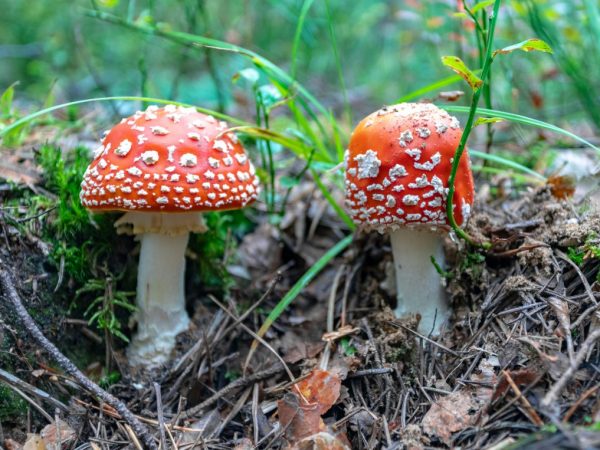
Poisonous mushrooms should not be picked
Avid mushroom pickers are familiar with poisonous species and will not put them in a basket. They know the blacklisted species. But sometimes even the most professional assemblers make mistakes. Before going into the forest, it is better to remember what poisonous and inedible mushrooms are found in the Urals. The most famous and frequently encountered are the following:
- false mushroom;
- Satanic;
- bilious;
- death cap;
- fly agaric;
- yellow-skinned champignon;
- the chanterelle is false.
Death cap
This fungus, not very large and simple in appearance, is dangerous. Its toxins are so strong that they can even penetrate the skin. Therefore, mushroom pickers do not touch the toadstool, they leave it to grow in its place. One touch of her on completely edible mushrooms will make them poisonous.
According to the description, it looks like a russula or mushroom, but there is no "skirt" on the leg. Her hat is whitish or brown-olive. There is almost no smell, completely tasteless. Grows in birch groves from June to the very frost.
Fly agaric
Of the poisonous, fly agaric is especially dangerous. In these forests, rare giant individuals are found, especially after good rains. It is after the rains that it is easy to confuse fly agarics with russula, because the white spots on their caps are washed out by water, they become almost invisible.
- the leg is high and slender;
- the color of the leg is white (or yellowish);
- grow in height up to 23-30 cm;
- the cap is flat, lamellar;
- the surface of the cap is reddish;
- there is a characteristic thin "skirt" under the hat;
- cap size - up to 30 cm.
Sometimes the cap is orange or pink, which makes it look like russula. The pulp is odorless and yellow in color.
False chanterelle
This representative of poisonous mushrooms grows in conifers. The hat looks like an orange-red funnel. The leg is hollow, cylindrical. These are autumn mushrooms. The mushroom places are the same as in the edible species, the common chanterelle, or cockerel.
Irina Selyutina (Biologist):
The fact that you cannot eat false chanterelles was an axiom for all mushroom pickers until recently. Recently, evidence has appeared that the false chanterelle (orange talker) has already been classified as conditionally edible mushrooms. But with the following caveats:
- before eating, this mushroom needs a particularly careful pre-treatment;
- people with a weak digestive system are strictly prohibited from eating them.
However, there are no confirmatory factors for the edibility of the orange talker, but there are reports of poisoning with this mushroom.
Weakly poisonous false chanterelles contain toxic compounds that are destroyed under the influence of high temperatures, or, in other words, thermolabile. However, at home, it is impossible to determine whether they all collapsed during cooking and the mushroom became harmless to health. Therefore, it will be safer to treat them as inedible mushrooms.
 In the forests of the middle zone, in the mountains of Kamchatka and on the Kola Peninsula, in the forest belts of the North Caucasus and the famous steppes of Kazakhstan, in the regions of Central Asia, more than 300 species of edible mushrooms grow, which lovers of "quiet hunting" like to collect so much.
In the forests of the middle zone, in the mountains of Kamchatka and on the Kola Peninsula, in the forest belts of the North Caucasus and the famous steppes of Kazakhstan, in the regions of Central Asia, more than 300 species of edible mushrooms grow, which lovers of "quiet hunting" like to collect so much.
Indeed, the activity is very exciting and interesting, which, moreover, allows you to feast on the harvested crop. However, you need to know the mushrooms so that poisonous ones do not get into the basket along with the edible ones, using which you can get severe food poisoning.Edible mushrooms with photos, names and descriptions are offered for familiarization to everyone interested in picking mushrooms.
Butterlets
There are several types of them. But in the taiga forests of Siberia and the Urals, the main one is butter dish, or, as it is also called, granular butter dish. His cap is covered on top with a yellowish-brown or brown thin, but dense film, which can be easily removed. But in wet weather, the film on the cap becomes sticky and slimy.
In young fungi, the edges of the cap are connected to the stem by a white film, which eventually breaks off the cap and remains on the stem in the form of a dark ring. The spongy part of the cap is tender, light yellow, the stem is short. The pulp is cool. You will take such a mushroom in your hand - like a piece of fresh butter from the refrigerator.
Consumption rate
It must be observed: too high an antiseptic concentration is harmful to leaves and roots.
Treatment of beds

How to process the soil with potassium permanganate?
- For 10 liters of water heated to 70 ° C, 5 g of potassium permanganate will be required. What if you don't have a scale at hand? One teaspoon without top - 13.5 g. Therefore, you need to measure out a little less than half.
- It is necessary to stir the solution until not a single undissolved crystal remains.
- Pour it into a watering can and pour a solution of 3-4 m² of beds or the same area of soil in a greenhouse, distributing the agent evenly. In this case, only the top layer of the soil is wetted. For complete soil cultivation, you will have to additionally use a solution of another fungicide. If you process the soil between the rows of strawberries in early spring with a hot solution or water the currant and gooseberry bushes with it until the buds are swollen, there will be fewer pathogens and pests on them - the hot solution will simply destroy them.
Soil cultivation with potassium permanganate is also carried out locally before planting seedling bushes. To do this, it is enough to pour a liter jar of solution into each dug hole. How to dilute manganese to process seedling substrate? The proportions for diluting the solution in this case are the same. It is better to spill the soil placed in seedling containers or cups. It will not be superfluous to disinfect peat tablets.
In the same way, soil disinfection for indoor plants is carried out.
For seeds and seedlings
A solution of an antiseptic for seeds is needed so that no pathogens remain on their surface. Its concentration is 0.5%, 0.5 g of the substance is dissolved in 100 ml of water. The seeds are immersed in the solution for 20 minutes. It is impossible to keep them in it longer: they can get burns, and their germination rate will decrease. For the same reason, seeds should be rinsed after disinfection.
For potatoes, such a solution is prepared - 1 g of potassium permanganate per 10 liters of water - and the tubers are kept for half an hour. The addition of only 2 g of copper sulfate will enhance the disinfection effect.
For the prevention of fungal disease, "black leg", the seedlings will have to not only treat the soil with manganese, but also water it once a decade with a solution of 3 g of the drug per 10 liters of settled water. Do not forget to clean the seed containers if you use them many times.
Ryzhik
This mushroom rightfully belongs to the first category. The cap of the saffron milk cap is reddish-red on top with a depression in the center in the form of a funnel. The lower part of the cap looks like it is made up of orange plates. The leg is short, also orange, hollow, on a cut it looks like a ringlet. On the break of the mushroom, an orange-red juice is immediately released. You touch the orange plates, just take them in, they immediately turn green. Ginger, unlike other mushrooms, is incomparably fragrant.
And in terms of calorie content, he excelled. If we talk about the calorie content of 100 g of product, then salted mushrooms surpass marinated porcini mushrooms by 67 calories, dried boletus mushrooms - by 8 calories, chicken meat - by 75.7 calories. It used to be that the French were sent from Russia salty mushrooms of the Urals in bottles. In Paris, they were more valuable than champagne. Such are they - mushrooms.

 Village Kosulino
Village Kosulino Lake Peschanoe
Lake Peschanoe